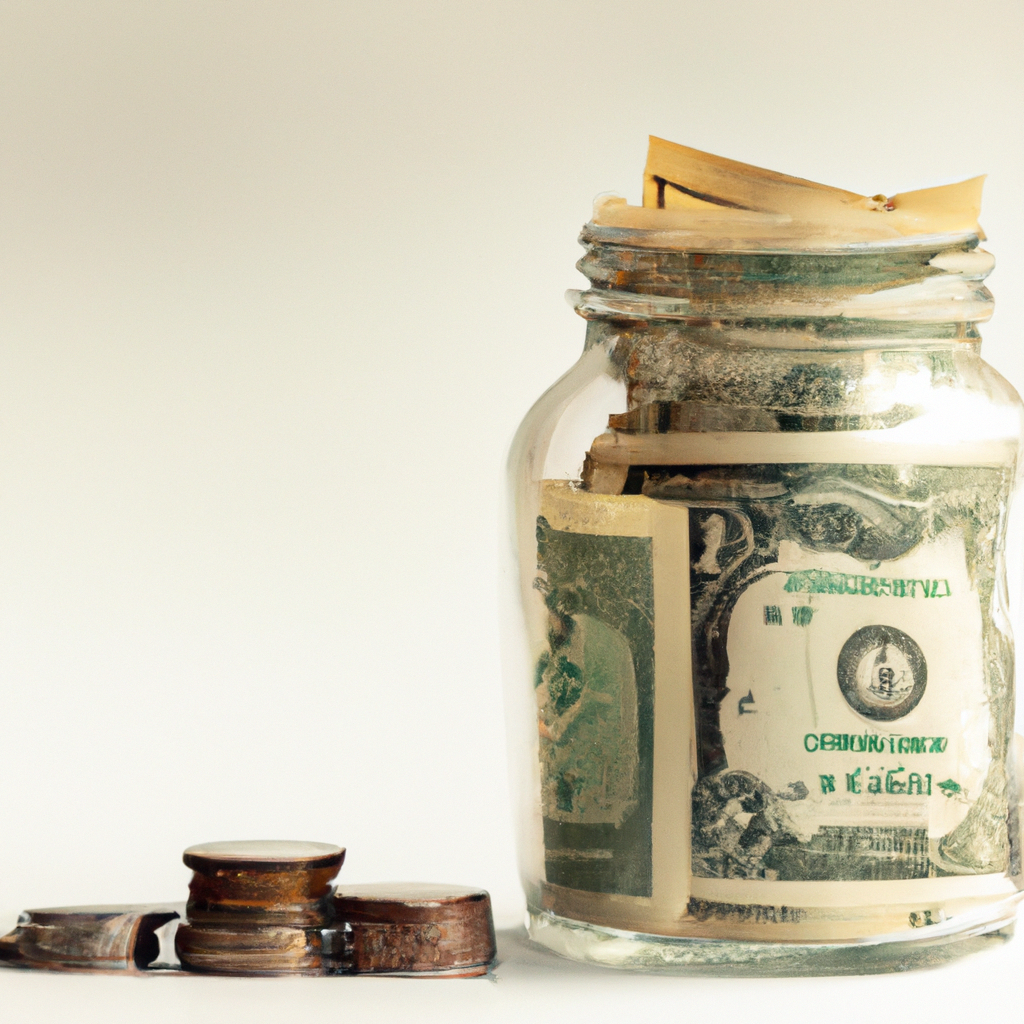Thinking about buying a home or making a big-ticket purchase but not sure how to save up for the down payment? Look no further! This article has got you covered. Whether you’re a first-time homebuyer or dreaming of that fancy car or dream vacation, saving up for a down payment can seem daunting. But fear not, because we’re here to provide you with some practical tips and tricks to help you reach that financial goal. So buckle up and get ready to embark on a savings journey that will bring you one step closer to making your dreams a reality.

Benefits of Saving for a Down Payment
Saving for a down payment on a home or a major purchase is a wise financial decision that comes with a multitude of benefits. Whether you are saving for your dream home or planning to invest in a property, having a substantial down payment offers financial security and stability. Additionally, it can lead to lower mortgage rates, easier loan approval, reduced monthly payments, and the opportunity to build equity and achieve homeownership.
Financial Security and Stability
One of the primary benefits of saving for a down payment is the financial security and stability it can provide. By having a substantial down payment, you are able to demonstrate to potential lenders that you are financially responsible and capable of handling the financial responsibilities of homeownership. This can give you peace of mind knowing that you have the financial resources necessary to cover unexpected expenses, such as home repairs or emergencies, without relying solely on credit.
Lower Mortgage Rates
Having a significant down payment can also lead to lower mortgage rates. Lenders are more likely to offer lower interest rates to borrowers who have made a substantial down payment, as it reduces their risk. With lower mortgage rates, you can save thousands of dollars over the life of your home loan. This not only makes homeownership more affordable but also allows you to build equity at a faster rate.
Easier Loan Approval
Saving for a down payment can significantly increase your chances of getting approved for a home loan. Lenders often require borrowers to have a certain percentage of the home’s purchase price as a down payment. By meeting or exceeding this requirement, you demonstrate your ability to save and manage your finances responsibly. This can make the loan approval process smoother, as it shows lenders that you are a low-risk borrower.
Reduced Monthly Payments
Saving for a down payment can lead to reduced monthly mortgage payments. With a larger down payment, you are borrowing less money from the lender, resulting in a lower loan amount. This, in turn, translates to lower monthly payments, allowing you to allocate your income towards other important expenses or savings goals. By reducing your monthly financial obligations, you can improve your overall financial well-being and increase your ability to save for future financial milestones.
Equity and Homeownership
One of the long-term benefits of saving for a down payment is the opportunity to build equity and achieve homeownership. When you make a substantial down payment, you immediately gain equity in your home. Equity is the difference between the market value of your home and the outstanding balance on your mortgage. As you continue to make mortgage payments and your home appreciates in value, your equity continues to grow. Homeownership not only provides a sense of pride and stability but also offers the potential for long-term financial growth.
Determining Your Down Payment Goal
Before embarking on your journey to save for a down payment, it is essential to determine a realistic goal. Setting a clear target will help you stay motivated and focused on achieving your savings objective.
Understanding Lender Requirements
The first step in determining your down payment goal is to understand the lender requirements. Different mortgage lenders have varying guidelines regarding the minimum down payment they expect from borrowers. It is crucial to research and familiarize yourself with these requirements to set a goal that aligns with the lender’s expectations. Typically, lenders expect a down payment ranging from 3% to 20% of the home’s purchase price.
Assessing Your Current Financial Situation
After understanding the lender requirements, it is important to assess your current financial situation. Evaluate your income, expenses, and existing savings to determine how much you can realistically afford to save each month. Consider your monthly cash flow, debt obligations, and any potential changes in income or expenses in the near future. This assessment will help you set a target that is within your financial means.
Considering Home Prices and Market Conditions
Another factor to consider when determining your down payment goal is the current home prices and market conditions. Research the housing market in the area where you plan to purchase a home and determine the average purchase price for properties that meet your requirements. Understanding the market conditions will give you a realistic estimate of how much you need to save for a down payment.
Setting a Realistic Target
Based on the lender requirements, your financial assessment, and the current market conditions, set a realistic down payment target. It is essential to strike a balance between an achievable savings goal and a down payment amount that will help you secure favorable mortgage terms. Consider setting milestone goals along the way to keep yourself motivated and track your progress effectively.
Creating a Budget to Save
Once you have determined your down payment goal, it is time to create a budget that will enable you to save effectively and efficiently.
Track Your Income and Expenses
Start by tracking your income and expenses to get a clear picture of your financial inflows and outflows. This will help you identify areas where you can reduce expenses and save more money towards your down payment goal. Use budgeting tools or apps to simplify the process and ensure accuracy in tracking your finances.
Identify Areas for Cutbacks or Savings
Once you have a clear understanding of your income and expenses, identify areas where you can cut back or save money. Look for discretionary expenses that you can temporarily reduce or eliminate to maximize your savings. Consider reducing dining out, entertainment expenses, or subscription services. Every dollar saved brings you one step closer to your down payment goal.
Set Monthly and Weekly Saving Targets
To systematically save for your down payment, set monthly and weekly saving targets. Break down your down payment goal into smaller, achievable milestones that align with your financial capabilities. This will make your savings journey more manageable and less overwhelming. Establishing saving targets will help you stay on track and monitor your progress effectively.
Automate Savings
Automating your savings can be a game-changer when it comes to reaching your down payment goal. Set up automatic transfers from your checking account to a dedicated savings account every time you receive your paycheck. By automating your savings, you remove the temptation to spend the money and ensure that you consistently contribute towards your down payment goal.
Choosing the Right Savings Account
Choosing the right savings account is crucial to make the most of your efforts in saving for a down payment. Consider the following factors when selecting a savings account.
Compare Different Types of Accounts
When selecting a savings account, compare different types of accounts offered by various financial institutions. Look for accounts that offer competitive interest rates, low fees, and favorable terms. Consider whether you prefer a traditional savings account, a high-yield savings account, or a certificate of deposit (CD), depending on your financial goals and time horizon.
Consider Interest Rates and Fees
Interest rates play a significant role in the growth of your savings over time. Look for savings accounts that offer competitive interest rates to maximize your earnings. Additionally, consider any fees associated with the account, such as monthly maintenance fees or transaction fees, and choose an account with minimal fees whenever possible.
Evaluate Accessibility and Liquidity
While you are saving for a down payment, it is important to have access to your funds when needed. Evaluate the accessibility and liquidity of the savings account you choose. Ensure that you can easily deposit and withdraw funds without incurring excessive penalties or restrictions. While it is important to have your money work for you, it is equally important to have it readily available when you are ready to make your down payment.
Explore Government-Assisted Saving Programs
In addition to traditional savings accounts, explore government-assisted saving programs that can help you accelerate your savings for a down payment. Programs such as the Individual Development Account (IDA) or the First-Time Homebuyer Savings Account (FHSA) may provide additional incentives or tax benefits to eligible savers. Research these programs and determine if they align with your financial goals and eligibility criteria.

Exploring Alternative Saving Strategies
Saving for a down payment does not have to be limited to setting money aside in a traditional savings account. Consider exploring alternative saving strategies to diversify your savings and potentially increase your returns.
Employer-Sponsored Retirement Plans
Contributing to an employer-sponsored retirement plan, such as a 401(k) or a 403(b), can be an effective way to save for a down payment while also investing in your future retirement. Take advantage of any employer matching contributions, as it essentially gives you free money towards your down payment. However, be mindful of any penalties or fees associated with early withdrawals from these retirement accounts.
Investing in Stocks or Bonds
If you have a longer time horizon and are willing to take on more risk, investing in stocks or bonds can provide higher potential returns compared to traditional savings accounts. Consult with a financial advisor to assess your risk tolerance and explore investment options that align with your goals. Keep in mind that investing in the stock market involves inherent risks, and it is important to do thorough research before making any investment decisions.
Utilizing Tax-Advantaged Accounts
Tax-advantaged accounts, such as a Health Savings Account (HSA) or a Flexible Spending Account (FSA), can provide additional opportunities to save for a down payment. These accounts offer tax benefits, allowing you to potentially save more money towards your down payment goal. Consult with a tax advisor or financial professional to understand the eligibility criteria and potential benefits of utilizing these accounts.
Crowdfunding or Peer-to-Peer Lending
Crowdfunding or peer-to-peer lending platforms can be alternative ways to generate additional funds for your down payment. These platforms allow you to request financial contributions from family, friends, or even strangers who are interested in supporting your goal. However, it is important to approach these options with caution and carefully assess the associated risks and legal requirements.
Managing Debt and Improving Credit Score
Managing debt and improving your credit score are crucial steps in preparing to save for a down payment. Lenders consider your creditworthiness when determining your eligibility for a mortgage, as well as the interest rate you may qualify for. Taking proactive steps to manage debt and improve your credit score can potentially save you thousands of dollars over the life of your mortgage.
Developing a Debt Repayment Strategy
Start by developing a debt repayment strategy to systematically pay down your outstanding debts. Make a list of all your debts, along with their respective interest rates and minimum monthly payments. Consider focusing on high-interest debts first to minimize the amount of interest paid over time. Explore debt repayment strategies such as the debt snowball method or the debt avalanche method to accelerate your progress.
Making Timely Payments
One of the most important factors in improving your credit score is making timely payments on all your debts. Late payments can have a significant negative impact on your credit score and may make it more difficult for you to secure favorable loan terms. Set up automatic payments or reminders to ensure that you never miss a payment and demonstrate responsible financial behavior to potential lenders.
Reducing Credit Card Utilization
Another key factor in improving your credit score is reducing your credit card utilization. Credit card utilization refers to the percentage of your available credit that you are currently using. Aim to keep your credit card balances low, ideally below 30% of your total available credit. Paying off your credit card balances in full each month can help improve your credit score and positively impact your ability to secure a mortgage.
Checking Credit Reports for Errors
Regularly check your credit reports from the three major credit bureaus – Equifax, Experian, and TransUnion – for any errors or inaccuracies. Mistakes on your credit report can negatively impact your credit score and potentially hinder your ability to secure a mortgage. If you spot any errors, promptly dispute them with the respective credit bureau to have them corrected.
Building Credit History
If you have limited credit history, it is important to start building your credit as soon as possible. Consider opening a secured credit card or becoming an authorized user on someone else’s credit card to establish a positive credit history. Make small purchases and consistently make payments on time to demonstrate responsible credit management. Building a solid credit history will increase your chances of getting approved for a mortgage with favorable terms.

Tips for Accelerating Your Savings
Accelerating your savings for a down payment can help you reach your goal sooner and potentially save on interest expenses. Consider implementing the following tips to boost your savings efforts.
Increase Your Income
While cutting expenses is an effective way to save more money, increasing your income can also have a significant impact on your savings. Explore opportunities for career advancement, negotiate a raise or promotion, or consider taking on a part-time job or freelance work. Every additional dollar you earn can be directed towards your down payment goal.
Minimize Unnecessary Expenses
Carefully evaluate your expenses and look for areas where you can make further cutbacks. Identify unnecessary expenses such as subscription services or memberships that you can temporarily or permanently eliminate. Consider downsizing or refinancing your car, reducing your monthly grocery bill, or finding more cost-effective ways to meet your daily needs. Every dollar saved adds up over time.
Negotiate Lower Interest Rates
Lowering the interest rates on your debts can free up additional funds to allocate towards your down payment savings. Contact your lenders and explore opportunities to negotiate lower interest rates on credit cards, personal loans, or other outstanding debts. A lower interest rate means less money spent on interest expenses and more money available for your savings goals.
Earn Extra Money through Side Gigs
In addition to your regular income, consider taking on side gigs or freelance work to generate extra income. Explore your skills and interests to identify opportunities for part-time work that can supplement your primary income. Websites and apps such as Upwork, TaskRabbit, or Fiverr can connect you with individuals or businesses in need of your services.
Utilize Windfall and Tax Refunds
Make the most of windfall money or tax refunds that come your way. Rather than splurging on unnecessary expenses, allocate these funds towards your down payment savings. Treat any unexpected money as an opportunity to boost your savings and bring yourself one step closer to achieving your homeownership goals.
Overcoming Challenges and Staying Motivated
Saving for a down payment can be a challenging and lengthy process. However, with the right mindset and strategies, you can stay motivated and overcome obstacles along the way.
Avoiding Impulse Purchases
One of the common challenges in saving for a down payment is avoiding impulse purchases. It can be tempting to spend money on non-essential items or experiences that provide immediate gratification. To combat this, practice delayed gratification by setting a rule to wait a certain period of time before making a purchase. This will give you time to consider if the purchase is necessary or if the money would be better saved towards your down payment.
Finding Support from Family and Friends
Having a support system can greatly impact your motivation and accountability in saving for a down payment. Share your goals and progress with family and friends who understand and support your financial aspirations. Engage in discussions about money management, seek advice from those who have successfully saved for a down payment, and surround yourself with individuals who can positively influence your saving habits.
Breaking Down the Saving Goal into Milestones
Long-term goals can be overwhelming, but breaking them down into smaller milestones can make the process more manageable and achievable. Celebrate each milestone reached along the way, whether it’s saving a certain percentage of your down payment goal or reaching a specific dollar amount. Setting smaller milestones allows you to track your progress and stay motivated throughout your savings journey.
Rewarding Yourself Along the Way
While saving for a down payment requires discipline and sacrifice, it is important to reward yourself along the way. Set aside a small portion of your savings to treat yourself to something you enjoy, whether it’s a dinner at your favorite restaurant or a weekend getaway. By incorporating rewards into your savings plan, you create a healthy balance between your financial goals and enjoying the present moment.
Visualizing Your Future Home or Purchase
Visualization is a powerful tool that can help you stay motivated throughout your savings journey. Take the time to imagine and visualize your future home or the purchase you are saving for. Create vision boards with pictures of your dream home or set reminders on your phone with motivational messages. By regularly visualizing your goals, you can stay focused on the end result and feel inspired to continue saving.

Monitoring and Adjusting Your Saving Plan
Monitoring your saving progress and adjusting your plan as needed is crucial to stay on track towards your down payment goal.
Regularly Reviewing Your Progress
Take the time to regularly review your saving progress. This can be done monthly, quarterly, or yearly, depending on your preference. Analyze whether you are meeting your saving targets, identify any challenges or areas for improvement, and celebrate your accomplishments. Regularly reviewing your progress allows you to make any necessary adjustments and stay motivated throughout your savings journey.
Modifying Your Budget as Needed
As your financial situation evolves, it may be necessary to modify your budget and savings plan. Life events such as changes in income, expenses, or financial priorities may require you to reassess your saving strategy. Be flexible and open to adjusting your budget as needed to ensure that it continues to align with your financial goals and aspirations.
Reassessing Your Down Payment Timeline
It is important to periodically reassess your down payment timeline. Factors such as changes in home prices, interest rates, or personal circumstances may impact the time it takes to save for your down payment. Be realistic and honest with yourself about any adjustments that may be necessary to your timeline. Remember that progress is progress, regardless of whether it aligns with your original expectations.
Seeking Professional Financial Advice
If you feel overwhelmed or uncertain about your saving strategies, consider seeking advice from a financial professional. They can provide guidance tailored to your specific situation and help you make informed decisions about your down payment savings. A financial advisor can help you navigate complex financial matters, ensure that you are maximizing your savings potential, and provide peace of mind throughout your savings journey.
Conclusion
Saving for a down payment on a home or a major purchase is a significant financial goal that comes with numerous benefits. By achieving your down payment goal, you can enjoy financial security, lower mortgage rates, easier loan approval, reduced monthly payments, and the pride of homeownership. To reach your savings goal, it is important to determine a realistic target, create a comprehensive budget, choose the right savings account, explore alternative saving strategies, manage debt, improve your credit score, and implement tips to accelerate your savings. Throughout your savings journey, it is essential to stay motivated, overcome challenges, and regularly monitor and adjust your savings plan. With determination, discipline, and the right strategies, you are well on your way to achieving your down payment goal and enjoying the benefits of homeownership.


